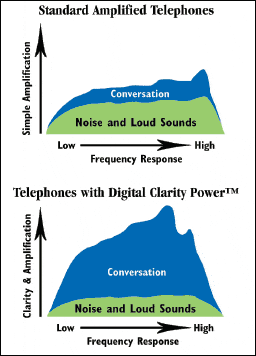New technologies extend the independent lifestyles of seniors—and the Baby Boomers to come
A few years ago, I started to notice that telephone conversations with my hard-of-hearing father in Denmark were becoming more and more arduous. Almost painful. No longer could I call him at a moment’s notice. Rather, I would have to clear my calendar and get a pot of coffee ready, because I knew it would take a lot of time, concentration, and patience. I’d had to repeat everything I said several times, and the distance between us only exacerbated the problem. The difficulty and time commitment eventually led us to limit our calls. I knew that one side effect of hearing loss is isolation from the outside world, and I began to worry.
I sent my father an amplified telephone, and now I no longer hesitate to pick up the phone and call him. We talk more frequently, and our conversations are more comfortable and natural. The easy rapport we’ve always enjoyed has returned to our phone conversations. The amplified telephone has made a world of difference in helping us remain connected and close; no longer will my voice be a distant memory to my father. This experience helped me better understand the struggles that individuals with hearing impairment face—and the importance of amplified telephony to their quality of life.
-
- FIGURE 1. Baby Boomer population (the 76 million people in the US born between 1946 and 1964) segmented by severity of hearing loss. Potentially, 38 million Baby Boomers suffer from some form of hearing loss.
More and more families are dealing with the effects of hearing loss. While hearing loss is the second most common condition in older Americans, research shows it is a growing problem among younger generations as well. Recent studies conducted by The EAR Foundation and Clarity show that Baby Boomers, who are now between the ages of 43 and 61, have more hearing-related problems than previous generations. Studies also indicate nearly half—or 38 million Baby Boomers—have some degree of hearing loss (Figure 1).
Of the Boomers with hearing loss, only 26% are using some form of assistive hearing device. Hearing aids are often the best solution, yet many who need them do not use them because they are too expensive and not covered by insurance.
Often referred to as the “sandwich generation,” because many are caught in the caregiving “sandwich” with growing children on one side and aging parents on the other, Boomers are using their pervasive influence over culture in general, and the technology industry in particular, to rewrite the rules of aging. Rather than surrendering to age-related disabilities like hearing loss, Boomers are demanding new and innovative products that greatly minimize what were once accepted as the inevitable aspects of growing older for them and the seniors in their care. So, as the number of people affected by hearing loss grows, the number of solutions is expanding as well.
DSP and Amplified Telephony
-
- FIGURE 2. A computer chip inside a DCP-powered phone runs various algorithms to improve listening conditions. For instance, one algorithm eliminates constant noise, such as air conditioning or static on the phone line, creating a clearer sound that is more conducive to conversation.
I became familiar with digital signal processing (DSP) technology through my years of work in the hearing aid industry. First used in 1987, DSP eventually revolutionized hearing aids when the technology came into widespread application in the late-1990s, significantly improving comfort, while reducing noise and feedback. So when I arrived at Clarity, I set about working with our engineers to incorporate this technology into amplified telephones as well.
This resulted in the development of Digital Clarity Power™ (DCP) technology, a solution for the growing number of people who are hard of hearing and unable to communicate effectively by telephone. Until this point, all amplified telephones had been analog, meaning they simply transmit whatever sounds are broadcast into a receiver. In contrast, DCP-enabled phones are designed to reduce unwanted noise (Figure 2).
Many people with hearing loss find that background noise can make normal telephone calls difficult or even impossible to understand. Analog amplified phones may compound this problem by amplifying static, sudden sounds, and other distracting noise. In contrast, a computer chip inside a DCP-powered phone runs various algorithms to improve listening conditions. For example, one algorithm eliminates constant noise, such as air conditioning or static, creating a clearer sound that is more conducive to conversation.
Today’s New Consumer
Amplified telephones now also feature all the “bells and whistles” of non-amplified phones. Boomers are demanding consumers and require all the common features associated with regular phones, including caller ID, call waiting, speakerphone, and digital answering systems. Other features specific to those with a hearing loss include large lighted keypads, visual ringers, and headset alerts. In the very near future, amplified telephones also will be able to slow the playback of the message or change the tone of a message if difficult to hear.
Amplified telephones are also becoming more ergonomic to compensate for dexterity issues. We are changing the shape of receivers to better accommodate a hearing aid. Evolving ergonomics are a testament to the growth of holistic solutions for hearing loss.

|
| FIGURE 3. The evolution of amplified telephones and assistive devices is revolutionizing the ability of seniors and people with disabilities to live independently in their own homes, vastly improving their communication and safety. These devices are evolving from stand-alone systems to integrated systems, where these devices will network with one another, as well as with other assistive devices and common home appliances (door knockers, motion detectors, etc), to systems that offer a wide array of connectivity options, including links to cell phones and the Internet. |
Despite its many advances, amplified telephony has not yet been able to overcome the challenges associated with wireless phones. This niche market is subject to very high turnover in product technology, which has made it difficult for amplified telephone producers to create a quality, cost-effective product. Nevertheless, the industry continues to strive for an affordable amplified mobile phone. In the meantime, cellular phones with full keypads have taken off in the deaf and hearing-impaired communities, making TTY/TDD devices a less frequent choice.
The intended uses of amplified telephones are expanding as well. The phones have evolved from stand-alone communication devices to integrated communication solutions that make the day-to-day life of a person with a hearing loss more manageable. Telephones can be plugged into lamp flashers to alert the consumer of an incoming call, or to a bed shaker, to arouse a person from sleep.
The Future and Smart Connectivity
-
- David Seabury and Brian Hill address hearing aid compatibility in the April 2007 HR article “Hearing Aid Compatibility (HAC) and Wireless Devices” available in the HR Archives.
The next step for amplified telephony is connectivity, in which products will be able to link to the outside world through proprietary and public networks. This charge will be led by advancements in ZigBee technology, a wireless, standards-based technology that offers many opportunities for remote monitoring and control and sensory network applications. The technology will be beneficial to many applications including wireless home security, remote thermostats for heating and air, and wireless smoke and carbon monoxide detection.
ZigBee technology is designed to work well for a wide range of services that would specifically benefit the hearing impaired or deaf communities and seniors, including emergency response and motion sensoring. For example, the ZigBee system could be programmed to alert a caregiver if no motion is detected in the home for an allotted amount of time. Technology like this gives peace-of-mind to caregivers and allow seniors to “age in place” and live independently for as long as possible.
Amplified telephony has come far, and we are excited about the advances that are close on the horizon. By engineering evermore innovative and advanced devices and services, we in the industry hope to provide greater options to help people maintain fully independent, active, and engaged lifestyles.

Carsten Trads is president of Clarity, a division of Plantronics Inc and a supplier of amplified telephones, notification systems, assistive listening devices, and other communications devices for the hearing loss and deaf markets. Trads has also served as president of a major hearing instrument manufacturer. Correspondence can be addressed to HR or Carsten Trads at .







